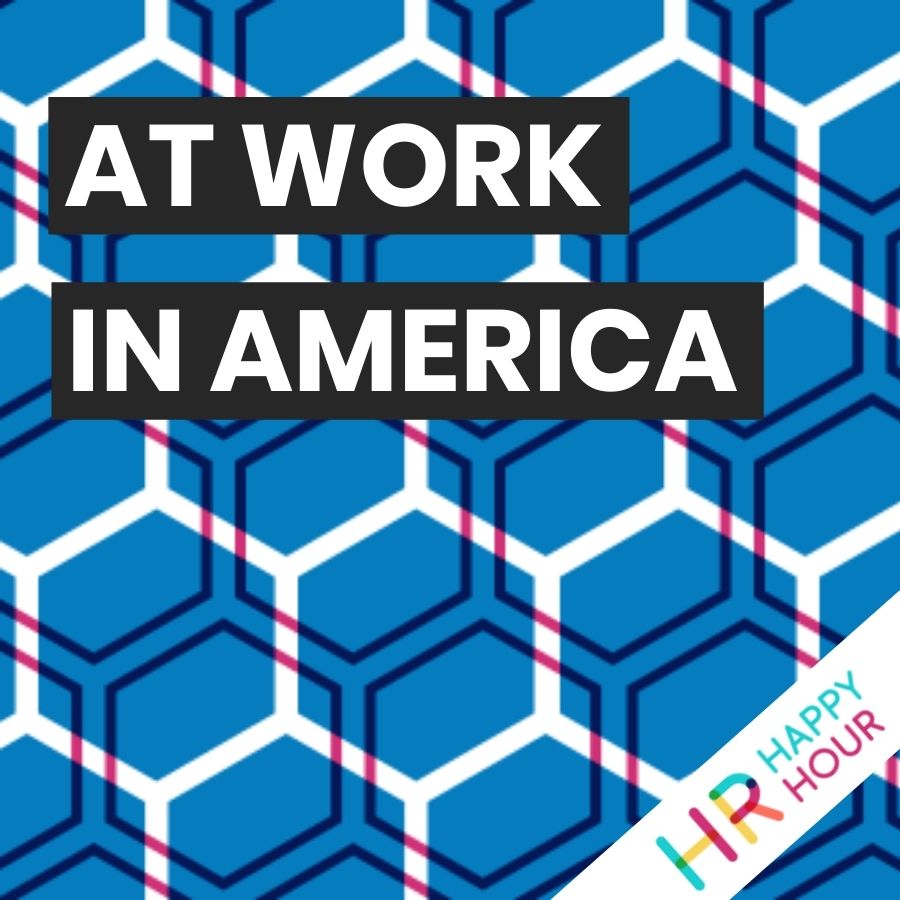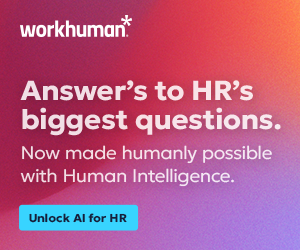Matching Talent With Opportunity: Indeed’s New Pay for Application Strategy
Hosted by

Steve Boese
Co-Founder and Chief Data Officer of H3 HR Advisors and Program Chair, HR Technology Conference

Trish Steed
Co- Founder and Chief Strategy Officer, H3 HR Advisors
About this episode
Matching Talent With Opportunity: Indeed’s New Pay for Application Strategy
Hosts: Steve Boese, Trish Steed
Guest: Raj Mukherjee, Executive Vice President and General Manager, Employer at Indeed
This episode of At Work in America is sponsored by Paychex, one of the leading providers of HR, payroll, retirement, and insurance solutions for businesses of all sizes. As the workplace continues to evolve, businesses are being forced to adapt and innovate to meet the challenge. Our fifth annual workforce trend study will help you understand this year’s top business challenges — and set your strategic priorities. Get the report, 2023 Priorities for Business Leaders: Trends, Insights, and Ideas for an Evolving Workplace to learn the challenges facing businesses like yours and how you don’t have to go it alone. Visit paychex.com/awia to check it out, today.
This week we met with Raj Mukherhee from Indeed to talk about about the current labor market, hiring, and connecting with quality talent.
– Current state of the labor market
– Employers are facing pain points and barriers to hiring
– How HR technology can help the inefficient hiring process
– Indeed is evolving to a matching and hiring platform
Thank you for joining the show today! Remember to subscribe wherever you get your podcasts!
Transcript follows:
Steve 0:28
Welcome back to the HR Happy Hour Show. My name is Steve Boese and I’m joined by Trish Steed. Trish, how are you today?
Trish 0:35
You know, Steve, I am fair to middling today.
Steve 0:40
Great answer I want you to know,
Trish 0:42
I’m great. I am great. It’s just I feel like I always say that guys, like, how are you guys like, oh, so good. Yeah, that’s an old phrase. Right?
Steve 0:51
We need to go back to the question of the day. I just sent you an old show from like, four years ago when we used to do question of the day and I would stump you with a weird question.
Trish 1:00
I need a question. Or would you rather something else?
Steve 1:04
Yes, let’s talk, I don’t know. How about bringing that back? But we have a great show today. We don’t need any games at the beginning of the show – no games. This is an exciting topic. And one, the labor market geek in me loves this topic. We’re going to be talking about the labor market, we’re going to be talking about hiring technology, and certainly some new innovations and hiring technology that are really going to benefit employers and hopefully facilitate better matching for job seekers and employers as well.
Steve 1:35
We’re happy today to welcome Raj Mukherjee to the show. Today, Raj is the Executive Vice President and General Manager for Employer at Indeed Trish, everybody knows Indeed, world’s largest job and hiring site, Raj is responsible for shaping product and go to market priorities for millions of employers, from small businesses all the way up to enterprise organizations around the world to help them match and connect with talent supplier with speed and simplicity. Raj was previously Indeed’s general manager of small medium sized business, and oversaw product growth in that segment and an international markets as well. And it’s our pleasure to welcome rush to the show. Raj, how are you today? Great to see you.
Raj Mukherjee 2:17
Great to see you Steve, great to see you Trish. Thank you for inviting me, really appreciate it.
Steve 2:21
Yeah, it’s our pleasure. We talked with our friends from Indeed in a while, which I love to because I love data. I love the labor market. So I love the intersection of the labor market and labor market data, which there’s no better source for.
Trish 2:36
Steve, this is like all your favorite things rolled up into one episode. Seriously. So this for you.
Steve 2:43
I was gonna wait to the end to mention German soccer, which is another one of my favorite topics of which Indeed, is a shirt sponsor from one of the teams from the German League, which I watch all the time. But that’s, we’ll save that to the end. Raj may start there. Wow, what a crazy labor market. It’s been here in the US specifically over the last few years, sort of through the pandemic era. I’d love for you to maybe give us some thoughts from a macro point of view about what indeed is seeing in the labor market today and the challenges that typical employers are still facing in 2023.
Raj Mukherjee 3:20
It’s a wonderful question and a great way to get started. You know, Steve, when I look back, targeting back a couple of years back, I mean, this field history, but it just happened in front of our eyes. 2020. Certainly COVID happened. And we all remember, the whole country shutdown. And unemployment rate just went through the roof.
Steve 3:43
Yeah, 14 and a half percent or so boom, in one year. It’s like, yeah, right.
Raj Mukherjee 3:49
I haven’t seen anything like what I hadn’t even imagined, I would see something like that. But, you know, we all, as they say, we all live to tell a story. And that’s a good story right there. So yes, unemployment goes to crazy, let’s call it 15%. And then all of a sudden the vaccine comes into the picture, the economy opens up, and everybody starts to hire. Everybody is like, you know, we need workers. And so at that time, what ended up happening? You have still the COVID problems, labor supply is still limited. On the other hand, you have huge, huge increase in demand. And so we saw that, Indeed, we saw that every everyone in the labor industry saw that. And what ended up happening is this crazy hiring means increase throughout all of 2022. And we know that the Fed at some point during last year, the exact date for their first rate hike escapes me wherever it was, and then they continuously increase rate with the explicit mandate. They just want to soften the labor market.
Raj Mukherjee 4:59
As that happens, we have seen, definitely we have seen some change in the overall labor market dynamics. You’re obviously seeing it in your data as well. I saw your recent article and tells all about that. But here’s the interesting news. It’s not the same across every sector. This is the most important part. People immediately look at hope there is slowdown, everybody stopping hiring. No, that’s not the case. Yes, there are some sectors that during pandemic, and post pandemic really hired a lot of people, particularly if you look at the tech industry, had seen a boom, like nothing like there was a great boom going on. But in particular sectors of tech, they have definitely slowed down dramatically. You’ve seen tech layoffs, take like actually take an go to a new level in the last, I would say definitely the last six months. But broadly, the overall industry, you still are looking at unemployment rates that are historically low. Very, very low.
Steve 6:04
Yeah, you gotta go back to the late 60s, really to see U.S. unemployment at about the level at which it’s kind of been hovering for a while now.
Raj Mukherjee 6:11
Totally. I mean, this kind of labor market is great for job seekers. And that’s good like we want I mean, we as a company, we live by our mission, we help people get jobs. And so for us, it is actually good news that the labor market is tight in the sense that more employ more job seekers are getting jobs that they want. And we’re seeing that I mean, this is one story that doesn’t get told as often. And you’re one of those people, actually aside, some of your commentary that I really liked. People who didn’t have an option to get a job in the past are starting to get jobs. Yes, remote work has taken shape. We know that as a trend. Lots of people who don’t want to relocate, or don’t want to go to office on a regular basis, they are getting jobs. But more importantly, there are some systemic changes that are also happening. People are oftentimes being open minded about a college degree. Do you need a college degree for a job or not? That’s changing. And so rather than me going into this very long monologue list, we can spend like hours talking about this. And I’m deeply passionate about it like it’s a very important area, I do see pockets of the industry still being very tight. And it’s not going to change immediately. demographics have changed, right? So we have we have a labor supply problem in certain industries that will continue.
Trish 7:33
Yeah, I you know, thank you for sharing that. And I’m glad that you mentioned that it’s in specific sectors, because I think sometimes when you watch the news, or maybe read in certain places, it doesn’t really put it quite that way. I know we have many barriers to hiring, and we did even pre pandemic, I’d love to hear just from your perspective, because you have such a wide perspective on hiring, have those barriers changed at all, whether before the pandemic or after the pandemic? And if so, what are some of those barriers and changes in hiring? That might be very different.
Raj Mukherjee 8:10
I’ll start with a story, as I say, pandemic created so many stories, right. So right at the onset of the pandemic, everybody said, I mean, basically coming close to another human being not possible. We were all scared of each other. Let’s be very clear, because we didn’t know who was going to carry the virus. And so at that point in time, one of the things that happened, people still needed to hire in critical sectors. But they wanted to hire without actually physically intervene. And there was a huge demand like we when we talk to customers, they’re like, Do you have a video interviewing solution? I want to see the person, I want to almost touch the person, but I can’t really touch the person. And can you give us a solution? And so we launched our video interviewing solution. And overnight, we saw a 1600% of a small base, but a 1600% growth at that point in time.
Raj Mukherjee 9:03
So why do I tell the story? It fundamentally changed one of the key barriers to hiring that I had heard a lot of times, I need to see the person to be able to hire. Yeah, I always used to hear that from hiring managers. How can I hire without seeing the person changed overnight? COVID just changed the way we think about hiring. And guess what, because we changed the way we think about hiring. It actually sped up hiring people who use video taping technology on our platform, their time to interview reduced by 20%. And this is I mean, you know, I’m talking about I’m sharing you need stats, I’m sure that anybody who is using other technology, they also saw some benefits, but with indeed we clearly saw a decrease in interview time. And we saw people actually starting to interview people that they would have not interviewed in the past. So that leads for your various to hiring question. People with disabilities, they are getting a shot at getting hired people without college degrees, they’re getting a shot at getting hired people who, oftentimes because of their background, and I mean, it’s a fact that I feel about 70 million plus people in the United States has some form of criminal record. And they were completely out of the picture from a hiring perspective. And they’re also starting to get an opportunity. People are being open minded about bringing them to work.
Raj Mukherjee 10:31
Yes, I mean, there’s a clear correlation between you getting a job, versus you going back to jail. If you get a job, you actually start a life and you have a better shot at a future. And we want that. And so recidivism, as we know, I mean, that can change if we can change the way people are hired. And so I do feel the barriers that we’re talking about whether it be physical disability, whether it be mental health issues, whether it be people’s ability to travel to a job location to even get hired people’s educational background, people’s unfortunate background as it relates to some criminal infraction that they had in the past. All of those things are getting reevaluated with the labor situation that we face. I think that’s great. That’s great for our overall industry. But it’s also great for us as a society. That’s the part I actually feel most grateful for that, yes, COVID was horrible. But it also at the same time, created a new labor dynamic that wouldn’t have existed had this not happened.
Steve 11:36
Raj, thank you for for that context. As we were chatting, we’re nodding our heads as you’ve been talking, because Trish and I have covered several of these subjects, even very recently, we just did a show about Second Chance Hiring, we’ve done a couple of them, but we just did want him two months ago or so maybe Trish around digging into those issues about formerly incarcerated individuals, and some programs that help them get back into the into the workforce. And I was also thinking, Raj, when you were talking about disabled folks, the unemployment rate, which is still high, comparatively, but the unemployment rate for disabled folks is at an all time low as well. Some of that is the tight labor market. Some of that is more firms, either by being forced to at the during the pandemic, or now, using to embracing hybrid work models or fully remote work models, which does open up opportunity for more folks who might have some disabilities and some challenges physically going into workplaces. So I agree with you, Raj, it’s been really revelatory. Our opportunity has been expanded right in the last couple of years, which is a great thing.
Raj Mukherjee 12:41
I’ll share a quick personal story if I may, like. So during the pandemic, we were doing some work in our house, one of the people that we had had to use because this was just out of necessity, we needed to get some of our electrical systems updated. So we got a local electrician to do a panel upgrade. And he comes to me and this guy basically looks at me and says, Oh, you work for Indeed, yeah. Can you help me hire an electrician? So he looks at me like, I really need to hire someone, can you help me hire? And so we talked about it, and a couple of months go by my product is done. He called me. And he says, hey, you know, I hired one, but he got another offer. And he has left. I’m willing to train someone, can you just hire me, someone who I will train our master electrician, I’ll get someone who is new, I’ll train that person and grow that person. Like, okay, I’ll help you post a job. And if he did post a job he gets got someone.
Raj Mukherjee 13:42
And the story is this guy, honestly, I mean, this, he would have not even considered anyway, he is he’s got a very high standard for his work, who never even considered someone in normal circumstances. But in a tight labor market. He’s open minded. He’s like, Yeah, you know, someone who is eager to learn who I can train and train that person. And we need that we need that such that the new workforce, we actually electrician is broadly an occupation, that we are going to need a lot of given the broad shift that we’re making into the new economy, right? Our environment is changing, we need to I honestly could care less what your beliefs are in that front. But the reality is, electric cars are not going anywhere. People are going to have to upgrade their panels at some point to accommodate for the new generation of cars. And so that that’s just one example of why you need electricians. We don’t have enough of them. So how do we create that and this concept that employers are going to train people not foreign to us used to happen in the past, someone went away is coming back.
Trish 14:49
Well, I love that you share that example. It’s interesting because we we have The Play by Play podcast, which is our Gen Z podcast and they actually just had someone who’s recently joined the workforce in carpentry. And we’re talking about students who are skipping college and going straight into the trades. I’d love to just hear a quick I know this isn’t the point of the show, but like what working at Indeed? Are you seeing more of that? Obviously, you give a great example of electrician, are you seeing more of the younger generation being open to those types of roles where they can train in the trades versus maybe a college degreed position?
Raj Mukherjee 15:29
You know, we don’t have any systemic data that I can share at this very moment. At the highest level, I’ll give you the broad generalized trends that I’m noticing. More and more employers are not requiring a college degree in their job descriptions. That is a fact like we are noticing, given these example, for majority of our jobs, no need for a college degree. You talked about second chance, we call it fair chance. And we, in our job descriptions, happy to share one of those for you if you want to show this in your podcast be great. Yeah, we actually make it a point that, you know, people should have a fair chance of being hired. And why I mentioned this, this aura about college degree and I’m having our 16 year old, I’m having this conversation with her. She’s a junior in high school. And one of the things we are genuinely having a deep conversation on like, look, the future, I don’t know what it looks like. There is a possibility that many of the white collar jobs that we know of today, they may not be as all it valuable in the future, as they are today.
Trish 16:44
Yeah. Well, you know, what, Steve, and I have kids in college as well. And I think that that is a discussion for the younger generation, because, you know, you’re looking at do I want to have $150 to $200,000 in debt to get this education that jobs are now starting to say isn’t necessary in many, you know, in many different fields. So, yeah, it’s a really interesting time. I think if you have high schoolers or even younger college students, try and figure out does this really make sense? And is it necessary? Or are there other alternative, you know, training opportunities through maybe apprenticeships? Or, you know, certainly you could do that in white collar jobs as well. Right. For many things we do. You could train someone, I could train someone to do my job. Steve could train someone to do his job. You know. So, yeah, it’s an interesting time.
Raj Mukherjee 17:36
Absolutely. And I mean, to your question, I talked to a lot of small businesses and large employers all the time. And when I talked to them, I asked this question very specifically, would you be open minded about training people for your entry level jobs? Many of them say yes. Right. So there is definitely an appetite and an interest, particularly in the segments where there is a real supply problem. People are like, yeah, no, I mean, it just makes sense for me to create a new workforce.
Steve 18:09
Yeah, I want to mention just something real quick. I was quickly looking this up because I wanted to make sure I got the reference out right just to show we did on second chance. Hiring it was like about a month ago feels like longer to me, it’s been a long few weeks, was with Aaron Smith was our guest from Escaping the Odds. And it’s on this feed on the At Work in America show feed and or the HR Happy Hour feed and just go back half a dozen shows, you can find it there. If you’d subscribe to the show, I would love to go and look at it. It’s really good. He was a really interesting guy had a great story in a background and himself as a formerly incarcerated individual, right, who’s taking on the mantle of this issue. And it’s super important.
Steve 18:45
And rush that sort of gets a little bit your story about the electrician. I swear, I could tell the same story in this area where I met with the plumbers, by the way, I could not find one to save my life. But which is this, that that particular person just having problems, right, getting enough people interested in the roles? What are the main kind is Indeed looks at the data and surveys your employers, right, millions of employers using the platform? What are some of the other barriers, just practical barriers to hiring? Is it just lack of enough candidates lack of qualified candidates is a competition. You know, wages are starting to temper a little bit wage growth year over year, but still wage growth had been accelerating in most industries for a while. So a little bit of an arms race going on. What are the things consistently you see from your employer? Clients?
Raj Mukherjee 19:40
You know, I mean, we did a recent survey of 600 US employers of all sizes, from very small to the very large ones. And there is a lot of internal data that we have on this as well, but we wanted to refresh that and looked at this sample of employers. And as part of that, they share the top barriers to hiring. The first one, which you would say, pretty self explanatory, we know this is happening, time it takes to hire. Very big challenge for many employers, second poor quality of candidates. And when I say poor quality of candidates, it’s not the candidates themselves. It’s the, you know, it’s the matching, that has happened with the employers expectations, and the candidates that are applying to that job or, and so that’s part of the problem. Third, competition from other companies, especially in hot sectors that we talked about intense competition from other competitors to hire. Not enough applications is also one of the problems in those sectors in particular.
Raj Mukherjee 20:43
And the last one, which is I think, where you and I see eye to eye a lot, which is lack of people resources to manage the hiring process. And this is where again, we do feel like all of these things we can solve as Indeed. But broadly, this last one is becoming an even bigger problem of late. I can last six months, we just talked about the tech industry going through some layoffs, but broadly, the HR and the tier departments in many companies have shrunk. Right. And that essentially means fewer people in those departments. But oftentimes, the hiring needs still exist, especially in some of these really difficult to hire segments, the hiring needs still exist. And so you have fewer people and more work needs to be done. Do more with less. And that is classically, I mean, one of the big challenges. I mean, that’s where I think technology needs to come in technology needs to be at the service of humans, to make human beings be able to connect much more seamlessly, much more faster during the hiring process. I mean, that’s my hope, like my vision needs vision, how can we make that hiring process much faster, much easier, such that we can make that human connection, the magic of two human beings being able to connect with each other happen, and happen much faster.
Steve 22:04
Raj, you mentioned technology, which then is a perfect segue into one of the primary reasons we wanted to sit down with you today. Let’s talk a little bit about the new technological and enhancements, innovations, whatever the right word is, that Indeed just recently rolled out, that are meant to do a couple of things, help improve the process help facilitate a more efficient process, make those matches better, faster, more efficient, and also give employers some more options and some maybe some more control over the process, as well as particularly in a really tough labor market where you may have to keep the job open and posted for quite some time to get the right candidate. And that’s just the reality. Right, and that electrician is a great example. I’d love for you, Raj to share a little bit about some of the most recent developments that you’ll be rolling out.
Raj Mukherjee 22:53
Great question. I mean, we know the situation out there. And we think that it’s the right time for us to roll out in the long term vision, the direction that we are going, you know, we started as a job search site taking a step back. That’s what we’ve been doing for the last 15 years. And we were also the first ones to roll out this concept of pay for performance, where we said you shouldn’t have to pay for a job post. As an employer, you should only pay when you actually get value. You should only pay when someone views your job when someone clicks on your job. So that’s good that’s worked well for us has worked well for our employers has worked well for our jobseekers.
Raj Mukherjee 23:32
But we don’t think that’s enough anymore. We need to give employers more options, more capabilities, we actually need to rethink and solve the hiring process in a way that’s much faster and much simpler. That’s what we intend to do with our evolution into this matching and hiring platform. And, Steve, you mentioned he started with matching at the core of everything we do at Indeed is matching. I mean, that could itself be a topic for one of our podcasts, I guess, because it’s so important. It’s about understanding to human beings, their needs, translating that into some form of technology, and being able to make the connection happen in a way that they want, to channels that they want. And how do we do that, at scale, for all types of jobs are all at a global scale. And so that’s what we are doing. And as we are doing that the other push that we are making also is how do you ensure that employers were telling us that hey, I want to pay for results. Majority of employers are saying, Yes, I used to pay for results with pay for performance pay per click to actually want to move forward and get to the point where I pay for applying people qualified apply. How do we do that? And so we have launched and for the last two years, we have been iterating and improving our experience, particularly in the US where majority of our employers can now select they get an option to select. I can pay for apply or I can pay per click or so that was the old way of paying versus a new way of being, which is people apply. And we’re seeing good traction with it. Lots of employers are choosing paper apply, and they’re excited about it. And they’re getting a ton of value from it. And we find that they’re coming back and posting their next job and using paper apply again, which is a good way to know whether they’re actually getting value or not.
Trish 25:22
Yeah, I’m so glad that you’ve made this change. Raj, could you talk, you mentioned that the quality of the applicant, right? Could you maybe just elaborate a little bit on that specifically, and it could be maybe from, you know, a story of someone company that’s already seen success doing that, like you mentioned, maybe with posting more jobs, but what do you think makes that a more qualified candidate, then then sort of the old method of, of, you know, payment?
Raj Mukherjee 25:52
Very, very good question goes at the heart of it. And so, look, when you post a job, one of the things we first do is based on your job title, based on your location, based on the things that you have described, we predict and recommend, what we call deal breakers. And we all understand these records conceptually, but I’ll just walk through like, let’s say, a posting a nursing job in New York, and the nursing job in New York, I say, you know, I need five years of experience in ICU. That’s a very specific type of experience. There are not that many people in New York who have that kind of experience with a nursing license in the state of New York.
Raj Mukherjee 26:31
So obviously, it shrinks the supply, but it also makes it very targeted for us. So we ask those questions, and we say, okay, the employers definition of quality in this case is they will only accept people in the state of New York location, they have to have a nursing license. Number two, they also have to have five years of ICU experience at the minimum. So when anyone tries to apply any job seeker tries to apply, we ask those questions. Based on the employers guidance, we actually filter out candidates who do not meet that criteria. So that first type of quality, there are other the machine learning stuff that we also do that really help us understand whether this is a good this candidate is a good fit for this job, are they likely to be responsive for this job, all those things. So in fact, are all of those in such that we only deliver candidates who are likely to lead to hire, ultimately for the job. But we know that we can’t get all of these things, right. Like, again, machine learning, by definition is a probability. So we will not get it right all the time. So we are doing something that has never been done. When we deliver the apply, we give the employer 72 hours to decide if this application meets their quality bar or not. And that’s a big deal. Like this is really where we are putting putting the money where our mouth is like an employer could decide that, hey, all these applications don’t meet my criteria that can happen. But we believe that that’s not going to be the case. In many cases, we will deliver applications that meet their criteria, but some may not.
Raj Mukherjee 28:08
And when we don’t meet the bar, what happens is the employer by rejecting those applications within that time window, they are giving us matching feedback. And that feedback loop we can personalize is application delivery for us. So when we when someone rejects that apply, next time, we will deliver a different apply that doesn’t have that constraint. And so all of this is it’s a learning ecosystem, this whole processes, I mean, the heart of it, indeed is a matching company. We are learning and matching and making this better and better every time an employee interacts with the system. But I do believe that again, for not for everyone, perhaps but for many employers, quality candidate is the way to go.
Steve 28:53
Yeah Raj, thank you for explaining that. And when I read through the announcement and learn more about it recently, to me, that was the part that really stood out to me that 72 hour window where employers have that power to review applications indicate that yay or nay basically. And and the second part that you described, so well, Raj was that feedback loop to the system itself to help it learn to help it get better and help it improve. Right because hopefully, what you’re trying to foster as well, it’s like long term relationship with with an employer right to to consistently come back and want to post their jobs and indeed and get quality hires in a timely manner, in an affordable manner. Right. And, and by learning through this process, that process the matching gets better. Employers feeling the jobs get better, and ultimately, what the real what we’re really all about, right is people get jobs that they want and can be successful in faster, right? And that’s really the goal.
Raj Mukherjee 29:50
I mean, anytime a job is open, whether it’s a small business or a large business, they’re losing money. Like this is the part that people oftentimes immediately think about hiring, there is a time to hire, there’s a cost to hire. But there is an opportunity cost as well. Like when you have an open role, you are not getting the job done lightly. Or you are having your current employees do more work to do that. And they’re not particularly happy over the reader. So, in the end, hiring is about business efficiency and driving business value. That’s why it’s so important to get this right.
Trish 30:26
Yeah, I’m glad you mentioned that opportunity cost because I think you’re right, we focus sort of on the actual hire or the role. We’re not really thinking about the stress and the hours we might be placing on our existing employees who were trying to retain. Right. So we’re talking about how stressed that well, and you know what, okay, so now that you’re joking, but that’s a good point.
Steve 30:50
Okay. This is a real thing that happened to me. I’m saying,
Trish 30:53
And that as someone who works from home, you’re, then it causes stress in your job, right? It’s a trickle down. Right. So not filling a role isn’t just about that one job, right. It’s this long process of how you’re impacting your customers, your employees. It’s such a huge impact. And I don’t know that we’re accurately measuring that. Right.
Raj Mukherjee 31:14
Yeah. I mean, look, there are many businesses that have to shut down on specific days or shut down earlier, because they don’t have employees, right. Oh, yeah. That’s why hiring is more business critical.
Steve 31:30
Yeah. And there’s some great additional stories we could probably tell and share. I love talking labor market stuff. I love talking about data. And I love sort of getting an understanding at a big picture level, but also how it relates to real individual organizations and businesses as well, right? Because, yeah, it’s one thing for us to sit here and say, Oh, unemployment, three and a half percent. Oh, there were six and a half million hires. Right. That’s all interesting stuff. I read about that stuff every month. But some of the things Raj shared, but individual companies, individual organizations, building the jobs that they need to fill, providing feedback into the the matching engine to order make facilitate better and faster hiring, going forward and getting people back to work or in work or in the right jobs.
Steve 32:13
So it’s really all about a very noble mission, which is why I love talking about it as well. And I’m, I’m happy that we had a chance to have Raj on and talk about some of the stuff. Raj, I want to thank you for your time. And congratulations to you and the team on the on these new announcements. And this new innovation, which is fantastic. For folks who want to maybe learn more, obviously, we’ve all heard of Indeed, right? It’s pretty simple. But we want to just send them to indeed.com. Dig into what’s happening on the employer side, and maybe I’ll just throw it to you for one last closing thought or two.
Raj Mukherjee 32:44
You know, that’s the best place, go to indeed.com. And you will find out a lot more about what we are doing. last thoughts, I would say, you know, Steve, and Trish like that, at the crux of it, our mission, we help people get jobs. That’s what we do every single day, every single person that Indeed wakes up and thinks about how do we help the world get better? And it’s it’s a really societal vision for us. It’s a huge burden that we carry on ourselves saying, how do we make the world are we making the world a better place for everyone, and our technology, the matching and hiring platform that we are building? Ultimately, it has to help all employers on all job seekers find value through it. We hope again, this is the first step to many more changes that we make. But this is not a one and done story. There’s going to be iteration. It might take us who knows maybe a decade to get this to the point where it’s used by everyone. But so be it. Let’s start now.
Steve 33:41
Yeah, I love it.
Trish 33:43
love that. Thank you for sharing that not just an announcement, but really giving us some context and showing the passion that you and your colleagues there have for this and that it is a mission, that it’s a very purpose driven mission. And there’s more behind it than just you know, what might appear on the surface. So I do appreciate that you have really articulated that to the audience. Thank you, Raj.
Steve 34:07
Thank you so much. Great to see you Trish. Great stuff. I love it. I love talking about jobs in the labor market. I will do this every week if we can get away with it. Do you want to send folks to indeed.com? We’ll also have some links in the show notes to some of the specifics on the announcements that Raj described on the application and the pay for results programs as well. There’s a link to something on our site, we wrote a little review of this solution as well on our site. We’ll link to that as well. And thanks to Raj and our friends at Indeed, Trish, thank you. Great to see you as well. And thanks, everybody for listening. All the show archives at HRHappyHour.net. My name is Steve Boese we’ll see you next time and bye for now.
Transcribed by https://otter.ai
Talk to us
If you want to know more about any aspect of HR Happy Hour Media Network, or if you want to find out more about a show topic, then get in touch.










